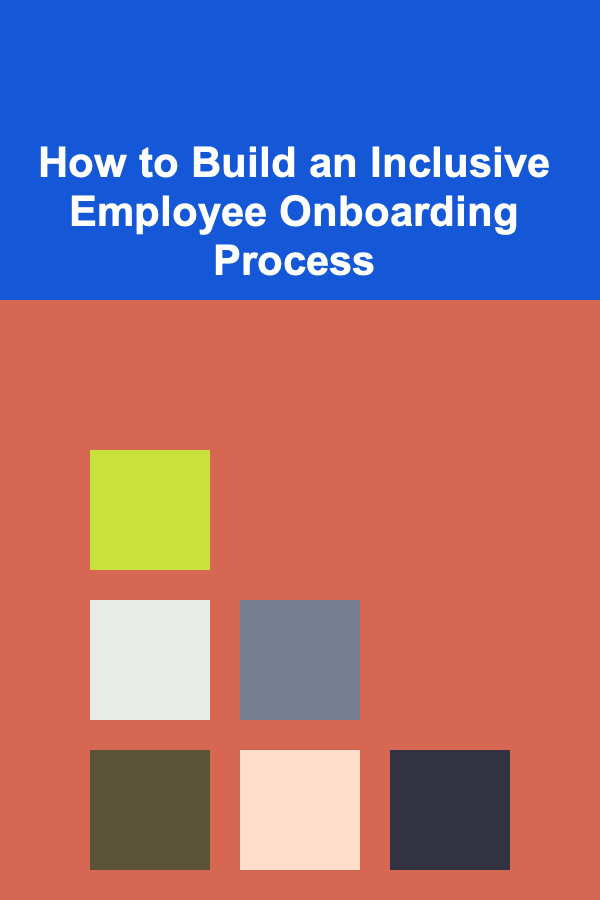
How to Build an Inclusive Employee Onboarding Process
ebook include PDF & Audio bundle (Micro Guide)
$12.99$6.99
Limited Time Offer! Order within the next:

An inclusive employee onboarding process is essential for fostering a diverse, equitable, and welcoming workplace. It's not just about completing forms or providing a company orientation---it's about creating an environment where every new hire, regardless of their background, feels valued, supported, and empowered from day one.
An inclusive onboarding process ensures that employees feel respected, heard, and understood. It's a key element in helping employees integrate into a company culture where they can thrive. For businesses, an inclusive onboarding process leads to better employee engagement, improved retention rates, and enhanced company reputation.
This actionable guide will walk you through how to design an inclusive employee onboarding process that can attract and retain diverse talent, and foster an environment of inclusivity that leads to long-term organizational success.
Understand What Inclusion Means in the Context of Onboarding
Before diving into the specifics of an inclusive onboarding process, it's important to understand what inclusion means in the workplace. Inclusion is about creating a culture where everyone feels respected and valued for their unique contributions. It goes beyond diversity (the mix of people) to address the ways in which people of different identities and backgrounds feel empowered and supported within the organization.
In the context of onboarding, inclusivity should be embedded in every step of the process---from recruitment to the first day on the job and beyond. It's about ensuring that new hires feel welcomed regardless of their race, ethnicity, gender, age, disability status, or any other aspect of their identity. Creating an inclusive environment sets the tone for their entire experience at the company.
Set the Right Expectations for All Employees
The foundation of an inclusive onboarding process begins before the first day a new employee steps into the office. Setting clear and inclusive expectations for both managers and employees is crucial for ensuring the onboarding process works as intended.
Clear Communication from the Start
When new hires are offered a position, it's essential that the hiring process is transparent and inclusive. Ensure that all communication with potential employees reflects your company's commitment to diversity and inclusion.
- Communicate your values early: Share your company's diversity, equity, and inclusion (DEI) policies with candidates during the recruitment stage. This allows them to see your commitment to fostering an inclusive environment.
- Give context to company culture: In your onboarding documents or introductory materials, explain your organizational culture, particularly as it relates to inclusivity, respect, and support for diverse perspectives.
Set Expectations for Managers and Teams
Managers play a critical role in making onboarding inclusive. Clear guidance for them on how to support new employees---especially those from underrepresented groups---will help prevent bias and ensure a smooth transition for new hires.
- Provide training for managers: Managers should receive regular training on inclusive leadership practices, which will help them to support all employees effectively.
- Foster an inclusive environment from day one: Managers should be briefed on how to encourage participation from everyone in meetings and respect all forms of communication, whether verbal or non-verbal.
Customize Onboarding Materials and Content
The content of your onboarding materials should reflect inclusivity. This doesn't just mean offering printed materials in different languages (though that's an important consideration)---it also means ensuring that the tone and content are accessible and relevant to all employees, regardless of their background.
Offer Diverse Representation in Onboarding Content
Diversity in imagery, language, and examples is critical. Make sure your onboarding materials---whether digital or physical---reflect diverse individuals in leadership, in different roles, and across different identities. This creates a sense of belonging for all employees and shows that diversity is valued at every level of the organization.
- Use diverse images: Ensure your onboarding documents, website, and training materials feature a variety of people---representing different races, genders, abilities, and cultural backgrounds.
- Ensure inclusive language: Check your materials for inclusive language that avoids stereotypes or biased assumptions. For instance, instead of assuming all employees are parents, use gender-neutral language when discussing family leave policies.
Accessibility Matters
Employees with disabilities may face unique challenges in accessing onboarding content. Make sure that your onboarding process is accessible to everyone.
- Provide content in accessible formats: This includes screen-reader-compatible documents, captioned videos, and large print materials for employees with visual impairments.
- Offer flexible formats: Not all employees learn the same way. Offer different formats of the same material---videos, reading materials, and interactive activities---so that employees can engage with the content in a way that suits them best.
Assign a Buddy or Mentor for Support
One of the most effective ways to integrate new employees into your company is by assigning them a buddy or mentor. This provides them with someone to turn to for guidance, support, and advice, which is especially important in an inclusive environment where employees may feel vulnerable during their first few weeks.
Create a Buddy System
The buddy system is a powerful tool in inclusive onboarding because it pairs a new hire with an existing employee who can help them navigate the organizational culture, answer questions, and offer advice in a safe and supportive way.
- Diverse buddy assignments: Pair new hires with a buddy who represents a different perspective or background, which can promote cross-cultural understanding and inclusion.
- Mentorship for all: If a new hire requests a mentor, be sure to provide one. A mentorship relationship can be especially beneficial for employees from underrepresented groups who might not always feel comfortable asking questions in a larger group.
Ensure Open and Honest Feedback Loops
Inclusive onboarding isn't just about making employees feel welcome initially---it's about building a long-term culture of feedback and improvement. Encourage new employees to share their thoughts on the onboarding process and be open to making changes.
Regular Check-ins
Conduct regular check-ins with new employees, especially in their first few months. This allows them to voice any concerns, feedback, or suggestions for improvement.
- Open-door policy: Foster an environment where employees feel comfortable speaking up if they have issues or concerns, especially if they don't feel fully included in the onboarding process.
- Solicit feedback actively: Don't wait for employees to come to you. Use surveys, focus groups, or one-on-one interviews to gather feedback about their experience with onboarding, and act on that feedback to continuously improve your processes.
Transparent Communication Channels
Make sure that new employees know where they can find the information they need. Whether it's questions about company policies, team structures, or available resources for inclusivity, provide clear and easy access to communication channels.
- Resource access: Provide employees with easy access to an internal knowledge base, where they can review company policies, DEI guidelines, and other relevant information at any time.
- Community-building initiatives: Encourage new hires to participate in employee resource groups (ERGs), cultural celebrations, or social events to build a sense of community within the company.
Measure and Adjust Your Onboarding Process
An inclusive onboarding process isn't a one-time effort---it's an ongoing process that requires continuous evaluation and adjustment. Measuring the effectiveness of your onboarding process is key to ensuring that it is truly inclusive.
Key Metrics to Track
- Retention rates: Track how many employees from diverse backgrounds stay with the company after their first year. If retention rates are lower for certain groups, this may indicate that your onboarding process needs to be adjusted.
- Employee engagement: Measure how engaged employees feel during their onboarding process. Are they participating in team meetings? Are they feeling valued and heard?
- Feedback and surveys: Regularly survey employees about their experience with onboarding, particularly focusing on how inclusive they felt the process was.
Continuously Evolve the Process
Based on the data you collect, continuously adjust your onboarding process to ensure that it meets the needs of all employees. This includes revisiting training materials, revising mentorship programs, or adjusting feedback processes to better reflect the needs of a diverse workforce.
Conclusion
Building an inclusive employee onboarding process is not a one-off task but an ongoing commitment to creating a workplace where all employees feel valued, respected, and empowered. It requires thoughtful planning, clear communication, and continuous evaluation. By ensuring that your onboarding process is inclusive, you set the foundation for stronger employee engagement, better retention rates, and a more harmonious and productive work environment.
By focusing on transparency, accessibility, mentorship, and feedback, you create a system where every employee---regardless of their background---feels confident in their ability to succeed and contribute to the organization's mission. The result is not just a diverse workforce but a truly inclusive workplace where everyone can thrive.
Reading More From Our Other Websites
- [Home Budget Decorating 101] How to Choose Affordable Window Treatments That Look Expensive
- [Organization Tip 101] How to Create a Productive Workspace with Technology
- [Home Lighting 101] How to Use Dimmable Lights to Set the Mood in Your Home
- [Stamp Making Tip 101] From Rubber Sheets to Artful Impressions: A Beginner's Guide to DIY Stamp Making
- [Home Lighting 101] How to Use Lighting to Make Your Home More Sustainable
- [Home Party Planning 101] How to Create a Kid-Friendly Home Party Menu That Parents Will Love Too
- [Personal Finance Management 101] How to Use Cashback and Rewards Programs to Save Money
- [Home Security 101] How to Improve Security with Motion-Activated Outdoor Cameras
- [Weaving Tip 101] From Thread to Tapestry: Mastering the Basics of Loom Weaving
- [Home Maintenance 101] How to Maintain Your Home's Paint and Finish for Longevity

How to Plan a Family Karaoke Night in Your Living Room
Read More
How to Plan a Seasonal Celebration at Home
Read More
How to Protect Your Finances with the Right Insurance
Read More
Unlocking Success as a Medical Researcher: A Comprehensive Guide to Research Methodology and Ethics
Read More
How to Research the Economic Impact of the EV Industry
Read More
Smoking Meats: A Beginner's Guide
Read MoreOther Products

How to Plan a Family Karaoke Night in Your Living Room
Read More
How to Plan a Seasonal Celebration at Home
Read More
How to Protect Your Finances with the Right Insurance
Read More
Unlocking Success as a Medical Researcher: A Comprehensive Guide to Research Methodology and Ethics
Read More
How to Research the Economic Impact of the EV Industry
Read More